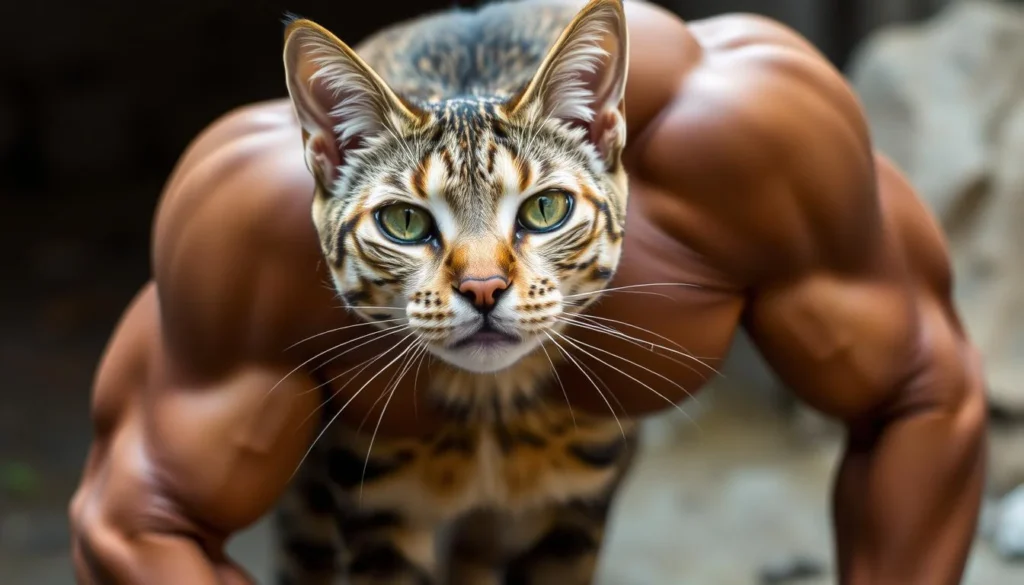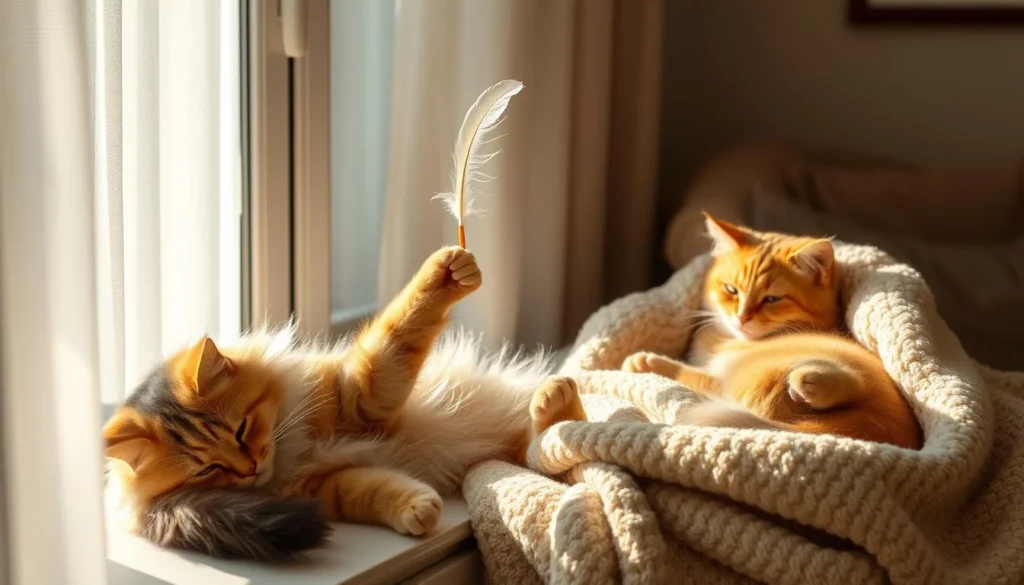Table of Contents
When I first brought home my male cat, I discovered a world of unexpected companionship. This experience changed how I see feline relationships. Male cats, or tomcats, show a unique mix of independence and affection.
Understanding male cats goes beyond simple stereotypes. They have complex personalities that challenge old views. Researchers at Oregon State University found that both male and female cats often choose human interaction, showing their deep social connections.
Your male cat’s behavior is shaped by early experiences and socialization. Kittens who get positive interaction before 12 weeks tend to be more friendly and adaptable. Breed characteristics also play a big role, with some like Maine Coons and Ragdolls showing stronger human companionship.
Key Takeaways
- Male cats can form deep, meaningful bonds with their owners
- Early socialization significantly impacts a cat’s personality
- Individual traits matter more than gender stereotypes
- Positive reinforcement is key for training tomcats
- Environmental factors strongly influence cat behavior
Understanding Male Cat Characteristics
Male cats have special physical traits that set them apart from females. These traits include coat patterns and body development. Knowing these can help you care for your cat better.

Physical Traits and Development
Unneutered cats have clear physical signs that show as they grow. You can tell a kitten’s sex when they are 6 to 8 weeks old. By 5 months, male cats usually have visible testicles.
- Male cats have a wider space (approximately 1 inch) between the anus and urinary opening
- Genitalia become more distinguishable between 6-8 weeks of age
- Testicles become visible around 5 months for unneutered male cats
Common Coat Colors and Patterns
Male cats have amazing coat color variations. Interestingly, orange tabby cats are predominantly male. About 80% of orange cats are male, making them special in the cat world.
The genetic likelihood of a male cat having tri-colored calico or tortoiseshell fur is an extraordinary 1 in 3,000!
Size and Growth Patterns
Male cats usually grow bigger and heavier than females. They tend to be more muscular and have stronger territorial behaviors. Their growth depends on genetics, diet, and whether they are neutered.
- Male cats are typically larger than females
- Body size varies based on breed and health status
- Neutering can impact physical development and behavior
Knowing these traits helps you care for your male cat better. It lets you appreciate their unique qualities.
The Truth About Male Cat Affection

Male cats are more than just a gender stereotype. They often show unique traits that break the mold of what we think of as male cats. These traits challenge our traditional views of masculinity in cats.
Many think male cats are always more loving. But, research shows it’s really about the cat’s personality and how they were raised. Not every male cat loves to cuddle, but many can form strong bonds with people.
“A cat’s affection is less about gender and more about individual experience and bonding,” says veterinary behaviorist Dr. Emily Roberts.
Several things affect how affectionate a male cat can be:
- Early socialization experiences
- Individual personality traits
- Neutering status
- Breed-specific characteristics
Neutered male cats tend to be more loving. Lower testosterone levels make them calmer and more open to people. Male Ginger Tabby cats, for example, are known for their affection.
How you bond with your cat is key. Positive interactions, gentle touch, and patient socialization can turn even the shyest cat into a loving friend.
Territorial Behavior and Marking Habits
Male cats have unique ways of showing they own a place. Knowing these habits helps keep your home free from unwanted marks.
Cats mark their territory as a way to talk to each other. They spray to leave their scent and tell other cats about their space.
Understanding Spraying Behavior
Spraying starts when male cats are about 6 months old. Unfixed males are most likely to spray. Here’s what you should know:
- They mark vertical surfaces
- They use small amounts of urine
- The smell is strong and full of pheromones
Managing Territory Disputes
When there are many cats, fights over territory can happen. Here’s how to keep peace:
- Have one litter box for each cat plus one extra
- Make sure each cat has its own food spot
- Give each cat its own place to rest
Prevention and Training Tips
To stop spraying, know what makes your cat upset. Neutering is the best solution, but some neutered cats might spray too.
Stress and big changes are big reasons for spraying.
Here are some tips to cut down on spraying:
• Clean with enzymatic cleaners to get rid of urine smells
• Keep your home calm and stress-free
• Make sure your home is a steady, peaceful place
Stopping spraying takes time and a careful plan for your cat’s health and happiness.
Male Cats: Health and Lifespan Considerations
Knowing about male cat health is key for pet owners. Male cats face special challenges that can shorten their lives. Their love for roaming and fighting can harm their health.
Indoor male cats usually live longer than outdoor ones. They can live from 14 to 17 years, sometimes even into their twenties. But, roaming puts them at risk for many dangers.
- Potential injuries from territorial fights
- Exposure to infectious diseases
- Traffic-related accidents
- Encounters with predators
Male cats’ aggression and need to mark territory can hurt their health. Unneutered males are more likely to get sick because of their roaming. Vets suggest several ways to lower these risks:
- Regular veterinary check-ups
- Maintaining a balanced diet
- Providing mental and physical stimulation
- Considering neutering to reduce aggressive tendencies
“Prevention is always better than cure when it comes to male cat health.” – Veterinary Experts
Good nutrition and care can help your male cat live longer. High-quality diets, enough water, and a calm home are important. They help keep your cat healthy and happy for years.
Neutering Benefits and Behavioral Changes
Neutering is key for male cats’ health and happiness. Unneutered cats face big challenges that neutering can solve.
Impact on Health and Longevity
Neutering male cats has many health benefits. Studies show it can:
- Reduce risks of certain reproductive cancers
- Prevent testicular diseases
- Lower aggressive behavior
- Decrease chances of getting feline viruses
Approximately 85% of male cats experience a reduction in problematic behaviors after neutering.
Behavioral Modifications After Surgery
Male cats change a lot after neutering. Actions driven by testosterone, like marking territory and fighting, lessen. You’ll see:
- Less wandering
- Less spraying
- More calm and predictable behavior
- Improved social interactions
Optimal Timing for Neutering
Vets say neuter male cats around 5 months old. This age helps stop unwanted behaviors and health risks. Early neutering improves your cat’s health and mood.
Neutering your male cat is a smart choice. It’s good for your pet and helps the cat community.
Social Dynamics and Bonding Patterns
Exploring the social lives of intact male cats shows us how special they are. They have their own way of interacting, unlike other cats. New studies have found interesting ways they bond and interact, changing what we thought we knew.
Male cats make deep connections through secret signals. Research shows they use their faces to talk to each other. Some studies found:
- 77% accuracy in detecting affiliative interactions
- Rapid facial mimicry within 1 second of observing another cat
- Specific ear movements are key for social bonding
Male cats do more than just mark their territory. They can become close friends with other cats, showing they’re not always aggressive. This is really interesting when they live with other cats.
“Cats have an extraordinary capacity for social connection that goes far beyond traditional understanding.” – Feline Behavior Researcher
Male cats are very good at fitting into social groups. They use:
- Subtle communication through body language
- Establishing hierarchical relationships
- Creating temporary and permanent social alliances
Knowing about their social lives helps us support our male cats better. It makes for a happier home for all cats.
Male Cat Care and Environmental Needs
Creating the perfect home for tomcats involves understanding their unique environmental requirements. Stud cats and domestic male cats alike need specialized care to thrive and maintain optimal health.
The American Association of Feline Practitioners highlights five critical elements for a healthy cat environment:
- Safety and security
- Separate environmental resources
- Opportunities for play and predatory behavior
- Consistent human interaction
- Respect for sensory needs
Creating an Enriched Environment
Your male cat needs mental and physical stimulation to prevent boredom. Interactive toys that mimic hunting behaviors can keep tomcats engaged and happy. Consider puzzle feeders, climbing trees, and scratching posts to meet their natural instincts.
Exercise and Play Requirements
Male cats require regular play sessions to maintain fitness and mental health. Aim for 2-4 play periods daily, each lasting about 5 minutes. Use toys that encourage jumping, chasing, and pouncing to simulate hunting experiences.
Dietary Considerations
As obligate carnivores, male cats need a high-protein, low-carbohydrate diet. Wet food can help increase hydration, which is important because many cats don’t drink enough water. Consult your veterinarian about the best nutrition plan for your specific tomcat.
“Providing the right environment is key to a happy, healthy cat.” – Feline Health Expert
Common Behavioral Challenges
Male cats can show complex behaviors that test even the most seasoned pet owners. Territorial behavior and aggression are big concerns, mainly in cats that haven’t been neutered. Knowing about these behaviors is key to a peaceful home.
Male cats often face several behavioral challenges:
- Urine marking and spraying
- Aggressive interactions with other pets
- Excessive vocalization
- Destructive scratching
- Nighttime hyperactivity
Territorial behavior shows up in different ways. Cats might spray to claim their territory, scratch furniture to mark it, or get aggressive when they feel threatened. These actions come from their natural instincts to survive.
“Cats communicate through behaviors that might seem puzzling to humans, but each action has a meaningful purpose.” – Feline Behavior Specialist
Dealing with these challenges needs a variety of strategies. Neutering can cut down on aggression and territorial marking. An enriched environment with lots of resources can also help reduce competition. Plus, playing with your cat can channel their energy into fun activities.
- Provide multiple scratching posts
- Use interactive toys
- Maintain consistent feeding schedules
- Create quiet, safe spaces
If your cat’s behavior doesn’t improve, it’s time to see a vet. A vet can spot any health issues or stress that might be causing your cat’s bad behavior.
Conclusion
Understanding male cats is more than just owning a pet. They have unique traits and personalities that make them special friends. Their territorial nature and affectionate side offer a rewarding bond with their owners.
Dealing with male cats requires patience, knowledge, and dedication. Neutering helps manage their behavior and keeps them healthy. Knowing their natural traits helps create a loving home for them.
Male cats are not just pets; they are unique individuals. They have their own ways of acting and socializing. Whether you’re getting a male cat or already have one, understanding and caring for them is key to a happy relationship.
Every male cat is different. While there are common traits, their individual personalities stand out. By being informed, patient, and caring, you can create a deep and joyful bond with your cat.
